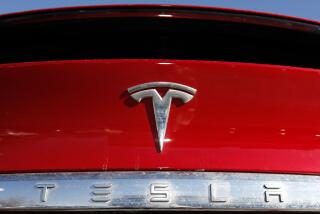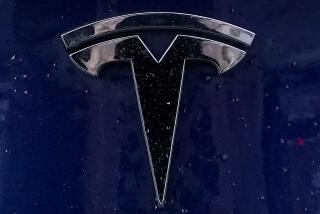Column: Tesla’s new Model 3 sedan has test drivers swooning — but quality issues lurk on the horizon
Tesla is on the verge of ramping up production of its mass-market Model 3 sedan, but the company has been giving hands-on demonstrations to selected journalists and financial analysts in recent months. With the first reviews trickling into print, we can judge the general reaction:
People love this car.
We can also spot one cloud on the horizon: Concerns about quality.
The latest comments on that issue come from Toni Sacconaghi, automotive industry analyst at AllianceBernstein, who examined and drove a new Model 3 at a Tesla demonstration in Brooklyn on Nov. 9. “Overall,” he told clients the next day, “we found the Model 3 to be a compelling offering, and believe it is likely to further galvanize the overall Electric Vehicle category.” But he also noted that “fit and finish on the two demo cars we saw — perhaps not surprisingly — was relatively poor.”
We can’t help noting that Tesla likely chose to share with us its highest quality/best assembled units, so issues on other cars may be even more pronounced.
— Toni Sacconaghi, AllianceBernstein
Among the shortcomings, two pieces of the glass roof on one of the cars seemed misaligned, with a gap that might allow water to leak into the cabin; body panels didn’t fit together; rubber trim wasn’t snug; and seams in the ceiling were misaligned. Sacconaghi allowed that such shortcomings might not even be noticed by most prospective buyers, but he was struck by the idea that these were demo cars likely to be examined by experts.
“We can’t help noting that Tesla likely chose to share with us its highest quality/best assembled units, so issues on other cars may be even more pronounced,” he wrote. If quality issues with the Model 3 turn out to be widespread, he observed, that could have important ramifications for Tesla’s brand. Tesla declined to comment.
The ramp-up itself poses a major problem for Tesla and raises questions about whether Tesla is focusing enough on the issue. Tesla and its founder/CEO, Elon Musk, often seem to be suffering from a sort of corporate attention-deficit disorder.
While the company is still struggling with what Musk has called “production hell” related to the Model 3 and its Gigafactory battery factory in Nevada, Musk took time out on Thursday night to unveil an electric semi truck and Roadster sports car — the first one aimed at production in 2019 and the second in 2020. “It’s just stupid,” Musk said at the gala, multimedia event.
He was using bro-speak to refer to the performance specs of the $200,000 Roadster, which he said will zip from zero to 60 mph in 1.9 seconds, with a top speed of 250 mph. But he might as well have been describing the act of distracting oneself from production at a critical moment. Tesla is also talking about manufacturing an SUV dubbed the Model Y.
All these rollouts generate publicity and flash, which may keep the investment markets enthralled. But what investors and buyers are going to be concerned about in the longer term is whether Tesla can manufacture trouble-free sedans, and at what quantity.
There is good news. The few test drivers who have had access to Model 3 demos almost uniformly give the car high marks. They praise the car’s pickup and handling, and even its minimalist interior and dashboard, which features a touchscreen instead of most of the dials and levers in conventional autos. “There’s nothing like it in the marketplace today,” Sacconaghi told me.
Many journalists got their test drives in July, so it’s unclear how closely the vehicles they drove resembled those that will be rolling off the Tesla assembly lines. More recently, Tesla offered hands-on rides to members of the financial community. Sacconaghi’s report is one of the first from a multi-day session offered to Wall Streeters, and his assessment tracks those from the summer. He had about two hours to examine two Model 3 sedans and drive one around Brooklyn streets.
“We thought the car drove very well,” Sacconaghi, who owns a Tesla Model X, says. “It was very consistent with the ride and performance of other Teslas. In fact, it was arguably so good, and its interior room so much better than I had anticipated, that it risks cannibalizing the Model S going forward.”
That poses a financial risk to the company, at least in the near term, he says. That’s because the Model S sells for $100,000 and gives Tesla a gross margin of $25,000 per car, Sacconaghi estimates, while the Model 3 will sell for about $44,000 reasonably decked out, with a target gross margin of $11,000. If prospective Model S customers decide to wait for a Model 3, Tesla’s profits will take a hit until Model 3 production ramps up toward the target of several hundred thousand vehicles a year.
As my colleague Russ Mitchell reported earlier this month, the company’s production goal of 5,000 Model 3 sedans a week by the end of December has been pushed back to the end of March. Among the reasons are production snafus at its Fremont, Calif., assembly plant and at the Gigafactory, the Nevada plant that supplies the Model 3’s battery packs.
In a call with analysts after the company released its third-quarter earnings on Nov. 2, Tesla founder and Chief Executive Elon Musk cited “production hell” at the Gigafactory, though he added, “I can see a clear path to sunshine.” Because of the production bottleneck, the company reported, only 260 Model 3 sedans had been produced, compared to the thousands that were supposed to have been turned out by now.
Many of those produced reportedly have been partially assembled by hand at Fremont. Sacconaghi believes that includes at least one of the two vehicles he inspected, which had a VIN indicating it was the 30th Model 3 produced.
Quality problems have dogged Tesla in the past, especially with the Model X, an SUV-style vehicle whose gull-wing doors, which hinge at the top, were a persistent issue early in their production run. Last May, Sacconaghi shared with clients his own customer service complaints, observing that the company’s “sales and service network is already strained, with processes not fully in place.” Tesla will be hard-pressed to ramp up its service operations once the Model 3 reaches customers in volume, in part because a larger share of buyers will see their Model 3’s as primary transportation and won’t take as kindly as X and S buyers to repair delays.
“There are going to be a lot of cars coming on the road at the same time,” Sacconaghi told me. “When Tesla produced the Model X there were a number of quality issues and the service centers got very busy. This is going to be a much, much higher-volume car, and if there are any quality issues that could overwhelm the service centers and undermine the Tesla brand. Those are questions no one really knows at this point.”
Quality issues could become especially costly if they trigger lemon laws. California, for example, requires that a carmaker refund or replace a vehicle if it spends more than 30 days out of service for warranty work in the first 18 months or 18,000 miles after delivery, whichever comes first.
Keep up to date with Michael Hiltzik. Follow @hiltzikm on Twitter, see his Facebook page, or email [email protected].
Return to Michael Hiltzik’s blog.
ALSO
Tesla’s entry into truck-making presents a whole new challenge for Elon Musk
Elon Musk’s SpaceX suffers a rocket-engine failure during testing
UPDATES:
10:45 a.m., Nov. 17: This post has been updated with reports of Tesla’s semi-truck and Roadster unveilings.
More to Read
Inside the business of entertainment
The Wide Shot brings you news, analysis and insights on everything from streaming wars to production — and what it all means for the future.
You may occasionally receive promotional content from the Los Angeles Times.











